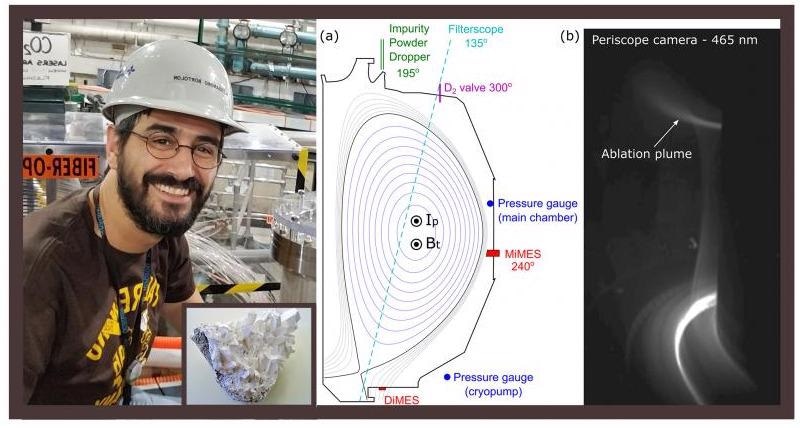Mar 31 2021
For individuals who wish to improve their chances of making electric current from fusion, they need not look any further than the cleaners stored under their kitchen sinks.
 Photos of physicist Alessandro Bortolon and the element boron; graph and photo showing the interior of a tokamak. Image Credit: Courtesy of Alexander Nagy and Alessandro Bortolon/Collage courtesy of Elle Starkman.
Photos of physicist Alessandro Bortolon and the element boron; graph and photo showing the interior of a tokamak. Image Credit: Courtesy of Alexander Nagy and Alessandro Bortolon/Collage courtesy of Elle Starkman.
A study headed by researchers from the Princeton Plasma Physics Laboratory (PPPL) of the U.S. Department of Energy has now confirmed that boron particles can coat the internal parts of tokamaks, which are doughnut-shaped plasma devices, and thus enhance the efficiency of the fusion reactions.
Boron is the primary ingredient used in the Borax household cleaner.
Our experiment brings key insights into how this technique works. The results will help clarify whether the controlled injection of boron powder could be used to support the efficient operation of future fusion reactors.
Alessandro Bortolon, Study Lead Author and Physicist, Princeton Plasma Physics Laboratory
Bortolon has reported the results in the Nuclear Fusion journal.
During fusion, light elements are combined in the form of plasma—the charged, hot state of matter made up of atomic nuclei and free electrons—in a process that can create a large amount of energy.
Researchers are now looking for ways to harness fusion, which drives the Sun and stars, to generate an almost unlimited power supply to produce electricity.
The team discovered that the boron injection method makes it relatively easier to create consistently high performance plasmas in tokamaks, with internal parts coated with light elements such as carbon, which is often utilized in existing devices.
These results were obtained from experiments conducted at the DIII-D National Fusion Facility, which is being operated by General Atomics on behalf of the DOE.
The study also complements previous results obtained from the experiments performed on the Axially Symmetric Divertor Experiment-Upgrade (ASDEX-U), which is managed by the Max Planck Institute for Plasma Physics in Garching, Germany.
Such experiments demonstrated that the boron injection method provides access to high-performance plasmas in tokamaks with internal components lined with metals, including tungsten.
Both the DIII-D and ASDEX-U experiments collectively offer strong proof that the boron injection method will ensure excellent plasma performance for an array of fusion systems.
The DIII-D experiments filled in a missing piece of data and demonstrated that the boron injection method makes it easy to add a boron layer into a tokamak.
You would intuitively think that when boron powder drops into the plasma, the boron would dissolve and go somewhere in the tokamak. But no one had ever tried to confirm the formation of a boron layer by the plasma itself. There was zero information. This is the first time this has been directly shown and measured using this technique.
Alessandro Bortolon, Study Lead Author and Physicist, Princeton Plasma Physics Laboratory
The boron layer prevents the transfer of material from the internal wall into the plasma and keeps the plasma free from contaminations that could otherwise dilute the main plasma fuel. With fewer impurities, the plasma becomes more stable and the frequency of disruptions is also reduced.
The boron injection method could supplement or even substitute the existing method for laying down a boron layer, which involves shutting down the tokamak for up to many days. Also called glow-discharge boronization, this technique even involves harmful gas. But now, the boron powder technique prevents all these problems.
If you use boron powder injection, you wouldn’t have to interrupt everything and turn off the tokamak’s magnetic coils. Also, you don’t have to worry about handling a toxic gas. Having a tool like this could be extremely important for future fusion devices.
Alessandro Bortolon, Study Lead Author and Physicist, Princeton Plasma Physics Laboratory
The study was funded by the DOE’s Office of Science (Fusion Energy Sciences). Collaborators in this project included researchers from the University of Tennessee-Knoxville, the University of California-San Diego, the Massachusetts Institute of Technology, Oak Ridge National Laboratory, and Lawrence Livermore National Laboratory.
Journal Reference:
Bortolon, A., et al. (2020) Observations of wall conditioning by means of boron powder injection in DIII-D H-mode plasmas. Nuclear Fusion. doi.org/10.1088/1741-4326/abaf31.